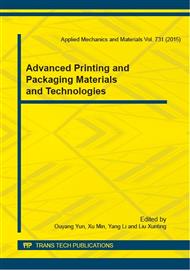p.506
p.510
p.515
p.520
p.524
p.528
p.535
p.541
p.547
Preparation and Study of Ink-Jet Printing of Ag Based Conductive Ink on Paper
Abstract:
Compared with the lithography and traditional technology, ink-jet printing technology has huge advantages such as reducing costs, improving production efficiency and reducing environment damage. The silver nanoparticles conductive ink used as core material in ink-jet printing technology has been greatly developed. At present, the conductive inks for printed circuit usually has high sintering temperature, low adhesion, poor mechanical properties, high cost, which limit the further industrial application. In this paper, nano silver pulp was prepared through liquid phase reduction method, and a self-made protective agent ensured that the particle size distribution of silver particles is about 5nm. The above silver pulp was dispersed in the organic resin to get conductive ink with 20% (wt%) silver content. Under 170°Csintering, the electrical conductivity of the ink layer was 1.15×104S/m.
Info:
Periodical:
Pages:
524-527
Citation:
Online since:
January 2015
Authors:
Keywords:
Price:
Сopyright:
© 2015 Trans Tech Publications Ltd. All Rights Reserved
Share:
Citation:


